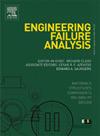Effects of sheet material and thickness on the quasi-static and fatigue failure behavior of self-piercing riveted steel-aluminum joints with edge riveting
IF 4.4
2区 工程技术
Q1 ENGINEERING, MECHANICAL
引用次数: 0
Abstract
The impacts of sheet material, sheet thickness, and edge distance on the mechanical properties and failure mechanism of steel-aluminum (steel as the top sheet) SPR joints under quasi-static loading are analyzed. The effect of edge distance on the fatigue life and failure mechanism of SPR joints is also discussed, and the fatigue life under different reliability levels is calculated using Weibull distribution. Results indicate that both bottom thickness and undercut values increase with higher material strength and sheet thickness, with minimal influence from edge distance. Insufficient clamping at the edge position results in decreased bottom thickness. All joints show an initial increase and then a decrease in peak loads with the increase in edge distance. Edge distances of 5.0 mm and 35.0 mm lead to reduced peak loads, whereas differences between edge distances of 15.0 mm and 25.0 mm are minimal. Compared to joints with edge distances of 15.0 mm or 25.0 mm, the peak loads of A5, B5, and C5 joints decrease by 19.3 %, 27.2 %, and 24.1 %, respectively. Similarly, the peak loads of A35, B35, and C35 joints decrease by 2.4 %, 12.8 %, and 16.8 %, respectively. The B35 joint is more suitable for low fatigue load levels, while B5 and B15 joints are better for higher fatigue load levels. Under quasi-static loading, five macro failure modes are identified: top sheet fracture, top sheet tearing, interlock failure, rivet fracture, and bottom sheet fracture. Under fatigue loading, B5, B15, and B35 joints exhibit mixed fracture, steel sheet fracture, and aluminum sheet fracture, respectively.
板料和厚度对边铆自穿孔钢-铝铆接接头准静态和疲劳破坏行为的影响
分析了准静态载荷作用下,板材材料、板材厚度和边缘距离对钢-铝(钢为顶板)SPR接头力学性能和破坏机理的影响。讨论了边缘距离对SPR接头疲劳寿命的影响及失效机理,并利用威布尔分布计算了不同可靠性水平下SPR接头的疲劳寿命。结果表明,随着材料强度和薄板厚度的增加,底部厚度和侧切值均增加,边缘距离的影响最小。在边缘位置夹紧不足导致底部厚度下降。随着边距的增加,各节点的峰值荷载均呈现先增大后减小的趋势。边缘距离为5.0 mm和35.0 mm时,峰值载荷降低,而边缘距离为15.0 mm和25.0 mm时,峰值载荷差异最小。与边距为15.0 mm和25.0 mm的节点相比,A5、B5和C5节点的峰值荷载分别降低了19.3%、27.2%和24.1%。A35、B35和C35节理的峰值荷载也分别下降了2.4%、12.8%和16.8%。B35接头更适合于低疲劳载荷水平,B5和B15接头更适合于高疲劳载荷水平。在准静态加载下,确定了五种宏观破坏模式:顶板断裂、顶板撕裂、联锁破坏、铆钉断裂和底板断裂。疲劳载荷作用下,B5、B15、B35接头分别表现为混合性断裂、钢板断裂和铝板断裂。
本文章由计算机程序翻译,如有差异,请以英文原文为准。
求助全文
约1分钟内获得全文
求助全文
来源期刊

Engineering Failure Analysis
工程技术-材料科学:表征与测试
CiteScore
7.70
自引率
20.00%
发文量
956
审稿时长
47 days
期刊介绍:
Engineering Failure Analysis publishes research papers describing the analysis of engineering failures and related studies.
Papers relating to the structure, properties and behaviour of engineering materials are encouraged, particularly those which also involve the detailed application of materials parameters to problems in engineering structures, components and design. In addition to the area of materials engineering, the interacting fields of mechanical, manufacturing, aeronautical, civil, chemical, corrosion and design engineering are considered relevant. Activity should be directed at analysing engineering failures and carrying out research to help reduce the incidences of failures and to extend the operating horizons of engineering materials.
Emphasis is placed on the mechanical properties of materials and their behaviour when influenced by structure, process and environment. Metallic, polymeric, ceramic and natural materials are all included and the application of these materials to real engineering situations should be emphasised. The use of a case-study based approach is also encouraged.
Engineering Failure Analysis provides essential reference material and critical feedback into the design process thereby contributing to the prevention of engineering failures in the future. All submissions will be subject to peer review from leading experts in the field.
 求助内容:
求助内容: 应助结果提醒方式:
应助结果提醒方式:


